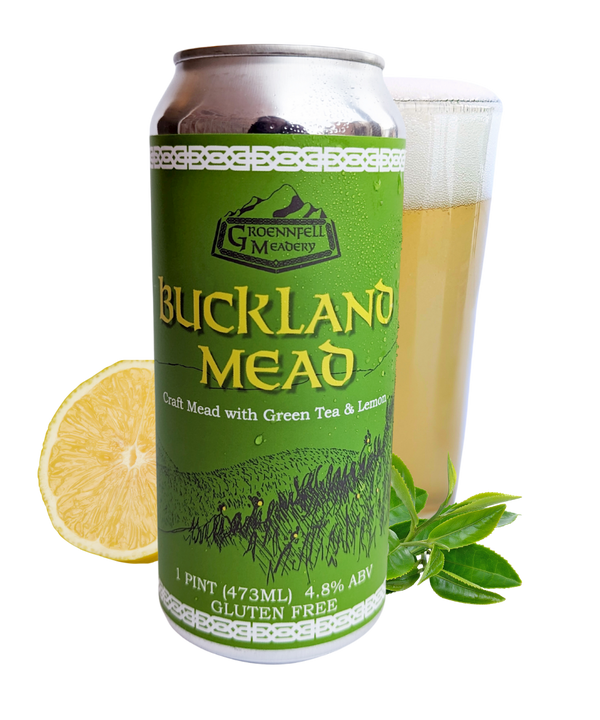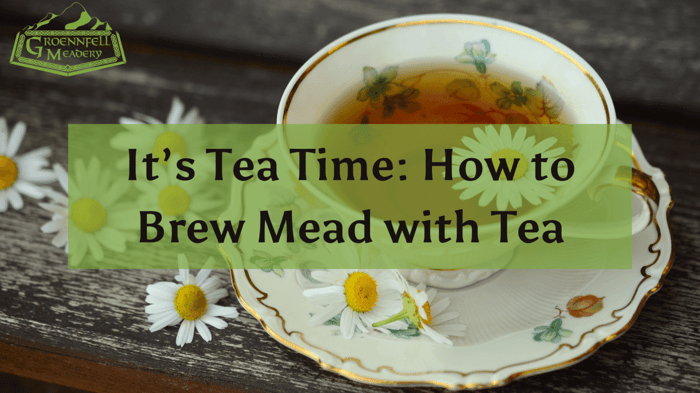
Updated March 2023
We’ve been playing around with making mead with tea for years. Way back in our homebrew days, we made dozens of different tea meads and regularly had one on draft.
It’s not just us, either. One of our most common class of questions on Ask the Meadmaker was things having to do with tea. (Check out Episode 66 - Ape Political and Episode 86 - Home Again for more on that.) Early on, we dis-recommended using Camellia sinensis - true tea - in meads, because in our own experiments we often got a highly tannic final product. We’ve learned a lot from the homebrew community since then (as well as our own experiments), and we’ll cover where we were going wrong and how to avoid that problem.
But first, some definitions
Before we get into the technical details of brewing (or is it double-brewing?) with tea, let’s get this out of the way: There is no agreed-upon name for a mead made with tea. It’s a mead, subclass metheglin, but beyond that there’s no consensus.
Camelliamel has a certain euphonious charm and tea mead is definitely straightforward. Teaglyn should be abandoned immediately since we don’t like to mix linguistic roots, and there’s probably a first-grader somewhere in the Hartford School District with that name already. For this article, we will just refer to it as Brewing Mead with Tea, since we’re discussing the process more than the final product. Please feel free to bicker about the name in the comments and on Facebook.
For the purposes of this article, we will also use the term tea to refer to anything commonly consumed like Camellia sinensis (also known as true tea). This would include yerba mate, rooibos, and chamomile, to name but a few. We are not talking about other spices which are sometimes referred to as a spice tea in brewing, since we’ve talked about that before.
Why make a batch of tea mead at all?
There are a lot of reasons we recommend giving it a try. First, and most obvious, is that tea meads are delicious. The reason we made so many of them is that they’re super fast and easy. You can even make them after the fact by adding a few ounces of tea to a pint that you have in front of you. There’s also the fact that a tea mead can be perfect for any season.
For instance, in 2022, we made Smoke on the Mountain which combines tea, lemon, hibiscus, and a merquén chili blend for a drink that’s perfect for the last cool days of spring and the first warm days of summer. Chamomile tea mead is fantastic for the fall. Although we haven’t personally tried it, a matcha mead after a day on the slopes sounds pretty darn good.
Now, the million-dollar question: How do you make a batch of mead with tea?
There are several ways to add tea to a batch of mead: dry, steeped, or a combination. And there are several times to add tea to a batch of mead: before, during, or after fermentation, or adding it throughout the fermentation process.
How to add it:
As a rule, we don’t recommend putting dry tea into your mead at any stage of the fermentation. The reason for this is more pragmatic than aesthetic: Tea is covered in microbes, some of which are pathogenic. This is one reason to always steep your tea at 160˚F or above.
Although no known pathogen that can harm a human can survive a mead fermentation, chances are pretty good that you’ll be introducing a souring bacteria if you just dump the tea leaves right in. The aesthetic reason is that alcohol extraction of tea doesn’t usually yield an agreeable product.
Our tried-and-true is to brew up a pot of strong tea. The rule of thumb[1] is roughly 1 oz. of leaves per quart of water, triple the steeping time, and go just a little bit low on the water temperature (185˚F seems to be good for black teas and 160˚F for green teas). Now pull out the tea leaves, and dump in the liquid (which is confusingly also referred to as tea).
How to avoid a tannin bomb
One easy option for avoiding too much tannin is to use a tea with little to no tannins, such as rooibos or chamomile. That’s one of the reasons that Buckland is so bright and refreshing; it’s brewed with green rooibos.

If you’re using true tea, follow the recommendations above, especially about the slightly lower water temperature. If you find that you’re still getting too much tannin in your batch, shorten your steeping time.
For a highly technical paper on the extraction rate of tannin as a function of temperature and time, you can check out this paper from the Faisalabad University of Agriculture.
When to add it:
Here there is substantially more flexibility. With more delicate flavors like tea, we tend to err on the side of adding later. This gives the yeast less opportunity to scrub out the flavor compounds you’re looking for.
Then again, there’s an old adage that says that you “taste it when you add it.” This means that if you put it in at the beginning of the fermentation, you’ll taste it as soon as it hits your mouth, but it will fade quickly. If you add it at the end, you’ll get it at the back of your palate. Whether this is true or not, many people believe it and follow the practice religiously. This would imply that tea should be added at multiple stages of fermentation for the full flavor experience.
Caffeine in Mead
Is there caffeine in tea mead? If it’s true tea or mate[2], then yes, but not very much. Assuming you add a whole pot of strong tea to a 5 gallon batch, you could anticipate about 8 mg of caffeine in your glass of mead. That’s 1/12th the amount of caffeine in a similarly-sized cup of coffee, or the same as a cup of decaf coffee. (Update 11/9/23: Mike from Filtered Grounds sent over this great, in-depth article about this for us to share.)
Smoke on the Mountain, for example, has about the equivalent of one cup of tea per can.
Tea Varieties
This is entirely up to you. It’s your mead. In fact, why don’t you experiment and let us know! There are lots of ways you could do it, and you can read more about experimental batches here. That’s it! Go out and brew, and… well, brew some more. Shoot us an e-mail with your results, or share them in the Facebook group!
Our Mead with Tea
We started our Tea Series in early 2022 with Smoke on the Mountain. Brewer Jon said of Smoke: "The flavor profile was from my original tea design which was ginger, cayenne, lemon. Then months later it really just came down to us wanting to have fun brewing something with tea doing experiments with random things in the walk-in to get close."
But Smoke on the Mountain it is far from the first tea mead that we have brewed.
The spring and summer seasonal favorite, Buckland, is made with green rooibos tea. As the ground thaws, and snows melt, and green things come back to the land, Buckland Mead springs into being. Buckland also includes fresh lemon and 100% wildflower honey, which might just make it the world's most refreshing mead.
Buckland by Groennfell - Green Tea Mead With Lemon - Limited Spring and Summer Seasonal

$19.99
As the ground thaws, and snows melt, and green things come back to the land, Buckland Mead springs into being. Made from fresh lemon, green rooibos, and 100% wildflower honey, Buckland might just be the world's most refreshing mead. Batch Notes: … read more
Footnotes
[1] This is not offensive. Google it.
[2] Yes, there is caffeine in mate. No, it is not a similar compound called “mateine.” Yes, I know your local tea shop told you this. No, they are not scientists. Google it. Also, you can’t wash the caffeine off tea with a quick dunk.







